Hey all, and welcome back to Magic Gatherings!
I hope everyone enjoyed last week’s trip down memory lane. This week, I’m back from vacation and we’re back to business: Battle for Zendikar previews have been rolling in for the last week and a half, and it’s time to start talking about them.
This set is difficult to preview because so many of its cards seem like they ought to be more than the sums of their parts. We’ve known all of Battle‘s themes since the PAX preview panels—all the mechanics like ingest/process, allies, and converge—but we don’t yet know which preview cards are the “setup” and which are the “payoff.” That means that while there are lots of neat cards to look at, it’s less clear what sorts of decks we’ll be able to build. We still have a pretty limited viewpoint.
Still, I’ll go though a bunch of cards today and give my thoughts on them—mostly thinking of Standard, but I’ll be sure to comment on cards with applications for Commander, as well. You can see everything that’s been spoiled so far on the Battle for Zendikar visual spoiler page over at wizards.com—be sure to check for more cards there! (Particularly since autocard links won’t work on this page until the set is loaded into the Wizards database, Gatherer.) Traditionally, the full set spoiler is released on the Friday or Monday before the prerelease (Sept. 26 and 27), so look for that this Friday (9/18) or Monday (9/21); I’ll be poring over it myself as I write next week’s limited set review.
Enough preamble—bring on the previews!
 We’ll start with what looks like one of the set’s chase mythics. Gideon is a powerful and flexible card which should contribute to a number of different strategies. For starters, his token-generating ability: it’s fairly similar to what we saw with [mtg_card]Xenagos, the Reveler[/mtg_card], who is about to leave Standard with Theros block. The tokens don’t have haste, but they do trigger any card you own that cares about Allies—so if you have a random Lantern Scout or Hero of Goma Fada on the battlefield, you’ll get the Rally bonus. The tokens can also be a source of continual pressure in an aggro deck, or a stream of chump blockers for a control deck.
We’ll start with what looks like one of the set’s chase mythics. Gideon is a powerful and flexible card which should contribute to a number of different strategies. For starters, his token-generating ability: it’s fairly similar to what we saw with [mtg_card]Xenagos, the Reveler[/mtg_card], who is about to leave Standard with Theros block. The tokens don’t have haste, but they do trigger any card you own that cares about Allies—so if you have a random Lantern Scout or Hero of Goma Fada on the battlefield, you’ll get the Rally bonus. The tokens can also be a source of continual pressure in an aggro deck, or a stream of chump blockers for a control deck.
If you need to, Gideon himself will get schwifty, which has been a characteristic of all his past incarnations. Ironically, Gideon never seems to see play because of this ability, but it’s nice to have. It’s easy to imagine an aggressive or midrange deck being interested in an effective 5/5 for four mana, and if a control deck can stabilize with Gideon’s tokens, he can clean up the opponent himself.
I’m also quite intrigued by his “ultimate.” Four mana is more than you would pay for [mtg_card]Spear of Heliod[/mtg_card] or [mtg_card]Glorious Anthem[/mtg_card], but Gideon’s emblem will never go away (emblems live in the Command Zone, and there are no cards which interact with them, so they can’t be targeted or destroyed), so all your creatures for the rest of the game will be better. Really, though, the big bonus is flexibility: you’re always going to be able to choose the option that’s best for you, and it’s clear all of Gideon’s other abilities are already good. That means you get the possibility to choose something else good, for free. That’s usually the hallmark of a stellar card.
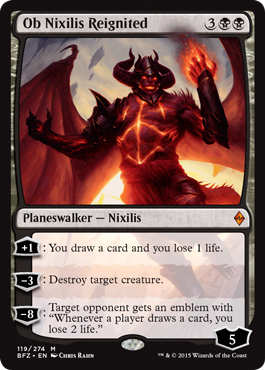 Ob Nixilis was introduced in the original Zendikar as [mtg_card]Ob Nixilis, the Fallen[/mtg_card]. Magic was at a particularly low point for story dissemination at that point, so I’m a little hazy on the details, but at the time he was a centuries-old demon and former planeswalker who had lost his “spark” and gotten stranded on Zendikar. Over the past year we’ve gotten little hints of his story: he tricked Jace into extracting the hedron that had been lodged in his head(!), becoming [mtg_card]Ob Nixilis, Unshackled[/mtg_card]. We also got a prequel card of sorts in Commander 2014‘s [mtg_card]Ob Nixilis of the Black Oath[/mtg_card], which depicted him in his former guise as a human warlord (he became a demon and his armor fused to his body later—again, kind of sketchy here).
Ob Nixilis was introduced in the original Zendikar as [mtg_card]Ob Nixilis, the Fallen[/mtg_card]. Magic was at a particularly low point for story dissemination at that point, so I’m a little hazy on the details, but at the time he was a centuries-old demon and former planeswalker who had lost his “spark” and gotten stranded on Zendikar. Over the past year we’ve gotten little hints of his story: he tricked Jace into extracting the hedron that had been lodged in his head(!), becoming [mtg_card]Ob Nixilis, Unshackled[/mtg_card]. We also got a prequel card of sorts in Commander 2014‘s [mtg_card]Ob Nixilis of the Black Oath[/mtg_card], which depicted him in his former guise as a human warlord (he became a demon and his armor fused to his body later—again, kind of sketchy here).
Ob Nix is back in business now, though, and like Gideon he’s a pretty straightforward, powerful card. I’m reminded a bit of [mtg_card]Liliana Vess[/mtg_card] and [mtg_card]Vraska the Unseen[/mtg_card], planeswalkers with similar costs who have played similar roles in midrange and controlling decks. Ob Nix is a little better than both, I think: his -3 isn’t as powerful as Vraska’s, but it will usually accomplish the same thing. And while he doesn’t grind your opponent out of cards like Lili, drawing cards of your own (even at the cost of life) is much better as a proactive way to get ahead. I like him a lot in Commander, as well, where you can play politics with his -3 and where I don’t think his card-drawing will be quite enough to paint a target on you.
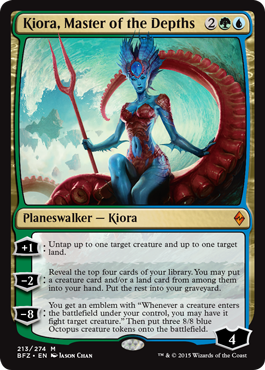 Kiora is back as well—and yes, that is the [mtg_card]Bident of Thassa[/mtg_card] (Theros’s god of the sea) she’s wielding now. Fashionable, no? Just the ticket for returning to her home plane and summoning up a combo of octopi to brawl with some Eldrazi.
Kiora is back as well—and yes, that is the [mtg_card]Bident of Thassa[/mtg_card] (Theros’s god of the sea) she’s wielding now. Fashionable, no? Just the ticket for returning to her home plane and summoning up a combo of octopi to brawl with some Eldrazi.
Kiora’s +1 is reminiscent of [mtg_card]Garruk Wildspeaker[/mtg_card]’s and [mtg_card]Ral Zarek[/mtg_card]’s, but I think it has higher upside than either one. While Nykthos, Shrine to Nyx is rotating (meaning that untapping a land will probably only give you one mana) there are also creatures like [mtg_card]Shaman of Forgotten Ways[/mtg_card] which really appreciate being untapped. That’s to say nothing of [mtg_card]Hangarback Walker[/mtg_card] (untap for an extra +1/+1 counter) or [mtg_card]Dragonlord Ojutai[/mtg_card] (untap to re-activate hexproof). I’m no Johnny/Jenny, but I think there’s a lot of potential there. In Commander, I once built a Sultai-colored “tap/untap” tribal deck: it was awful, and some of that was intentional, but the point is that with a wide card pool you can find lots of interesting things to do.
Kiora’s -2 also seems quite good. It’s usually going to be as good as drawing two cards (you won’t hit two cards every time, but you also get some card selection) and it fuels your graveyard for delve—a pretty serious consideration since we are losing [mtg_card]Satyr Wayfinder[/mtg_card].
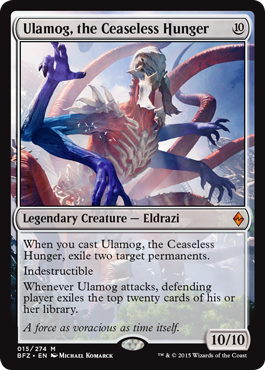 Heroes gotta fight something, right? Ulamog is an interesting card, as far as big bads go. First, unlike most creatures this big, it doesn’t have any “anti-reanimation” clause which would shuffle it back into your deck when it hits the graveyard (see previous incarnation [mtg_card]Ulamog, the Infinite Gyre[/mtg_card], for example). That means it’s only a [mtg_card]Necromantic Summons[/mtg_card] away. That said, as a reanimation target, Ulamog is hardly game-winning. It’s huge, but lacks evasion: instead, it has its strange exile ability, which will certainly kill in two or three swings. I’d be more bullish on its indestructibility, but we should be seeing a lot of exile soon, so I don’t think that’s as much protection as it otherwise might be.
Heroes gotta fight something, right? Ulamog is an interesting card, as far as big bads go. First, unlike most creatures this big, it doesn’t have any “anti-reanimation” clause which would shuffle it back into your deck when it hits the graveyard (see previous incarnation [mtg_card]Ulamog, the Infinite Gyre[/mtg_card], for example). That means it’s only a [mtg_card]Necromantic Summons[/mtg_card] away. That said, as a reanimation target, Ulamog is hardly game-winning. It’s huge, but lacks evasion: instead, it has its strange exile ability, which will certainly kill in two or three swings. I’d be more bullish on its indestructibility, but we should be seeing a lot of exile soon, so I don’t think that’s as much protection as it otherwise might be.
Of course, if you cast Ulamog honestly, you get to exile two things, which should either catch you up or put you very far ahead. As I mentioned earlier, though, it’s not clear what the tools for a dedicated ramp deck will be. (It is worth noting that with Shaman of Forgotten Ways and Kiora, you can get to ten mana as early as turn five.) Even if that deck exists, Ulamog will have to compete with Dragonlord Atarka, who might be even more effective. Ulamog is favorful, weird, and cool, but as of now the jury’s out.
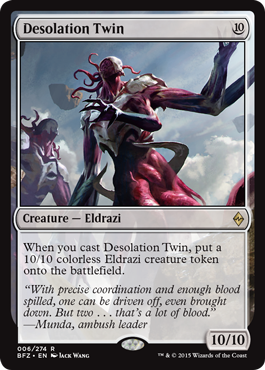
 Of course, it wouldn’t really be an Eldrazi party if Ulamog didn’t bring a bunch of friends along. Desolation Twin and Void Winnower are similar to their lineage sire in that they’re enormous, expensive ramp targets which aren’t clearly good enough to justify having a whole deck built around reanimating or resolving them. Twin definitely wins points in my book for being a clean, aesthetically pleasing design—and also for just dropping 20 points of power on the board, period. As with Ulamog, you get something for casting it (in this case, the token), so you have some assurance that it will at least trade for multiple cards. Void Winnower is just bizarre, which I’m sure is the impact they were designing for, so kudos for that.
Of course, it wouldn’t really be an Eldrazi party if Ulamog didn’t bring a bunch of friends along. Desolation Twin and Void Winnower are similar to their lineage sire in that they’re enormous, expensive ramp targets which aren’t clearly good enough to justify having a whole deck built around reanimating or resolving them. Twin definitely wins points in my book for being a clean, aesthetically pleasing design—and also for just dropping 20 points of power on the board, period. As with Ulamog, you get something for casting it (in this case, the token), so you have some assurance that it will at least trade for multiple cards. Void Winnower is just bizarre, which I’m sure is the impact they were designing for, so kudos for that.
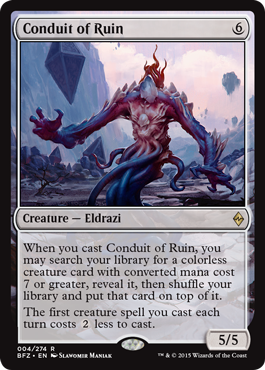
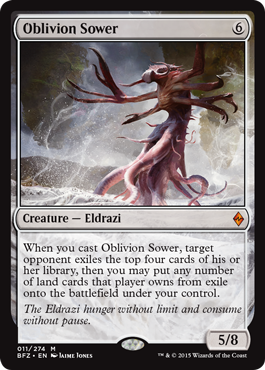 It might be more realistic to build our hypothetical Eldrazi Ramp deck around Conduit of Ruin and Oblivion Sower. As intermediate ramp targets go, you could do worse: a 5/5 or a 5/8 for six mana isn’t embarrassing, and each makes it easier to cast the next monster up the curve in their freakish Eldrazi way. Conduit of Ruin, home to one of the strangest ramp effects I’ve seen in a while, will even find it for you, which means more of your deck can focus on a realistic game plan (ramp to six mana and start dropping these guys) as opposed to shoving four Ulamogs in your deck and hoping you get there. Still, I’m not sure; neither of these monsters affect the board when you cast them, and they don’t leave much behind for your troubles compared to something like [mtg_card]Wurmcoil Engine[/mtg_card].
It might be more realistic to build our hypothetical Eldrazi Ramp deck around Conduit of Ruin and Oblivion Sower. As intermediate ramp targets go, you could do worse: a 5/5 or a 5/8 for six mana isn’t embarrassing, and each makes it easier to cast the next monster up the curve in their freakish Eldrazi way. Conduit of Ruin, home to one of the strangest ramp effects I’ve seen in a while, will even find it for you, which means more of your deck can focus on a realistic game plan (ramp to six mana and start dropping these guys) as opposed to shoving four Ulamogs in your deck and hoping you get there. Still, I’m not sure; neither of these monsters affect the board when you cast them, and they don’t leave much behind for your troubles compared to something like [mtg_card]Wurmcoil Engine[/mtg_card].
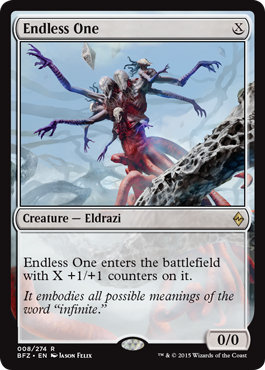 Endless One is pretty interesting, though. It’s never going to be amazing, but it will always be efficient, and the kind of flexibility it offers—you can always cast it, you can always sink all your mana into it if you want—is very easy to underrate. I expect this to show up in a lot of decks, even beyond Eldrazi Ramp (where it will be good: it gives you some early defense if you need to stall, and gives you something to do with all your mana when you draw it late). With this and [mtg_card]Hangarback Walker[/mtg_card], we could be pretty close to some kind of exotic [mtg_card]Hardened Scales[/mtg_card] deck, which would be pretty neat.
Endless One is pretty interesting, though. It’s never going to be amazing, but it will always be efficient, and the kind of flexibility it offers—you can always cast it, you can always sink all your mana into it if you want—is very easy to underrate. I expect this to show up in a lot of decks, even beyond Eldrazi Ramp (where it will be good: it gives you some early defense if you need to stall, and gives you something to do with all your mana when you draw it late). With this and [mtg_card]Hangarback Walker[/mtg_card], we could be pretty close to some kind of exotic [mtg_card]Hardened Scales[/mtg_card] deck, which would be pretty neat.
As an aside, I’d also like to critique the design aesthetic here. Even though all these cards are Eldrazi, none of them have abiding mechanical cohesion (apart from all being big, colorless, and a little weird). In Rise of the Eldrazi, the big colorless haymakers all had annihilator, which gave them a concrete mechanical identity and unity. When your opponent tapped out for a huge Eldrazi, it was important: it was going to have a powerful ability that would alter the way you played the game. This new batch are all just big and colorless. Maybe that’s enough, but I’m not convinced at this point. It also makes the Eldrazi more directly comparable to creatures we can already cast (read: [mtg_card]Dragonlord Atarka[/mtg_card]), so they don’t feel as interesting or as special, which is kind of a shame. We see a lot of fatties in Magic. These fatties are big and colorless, but not necessarily big and colorless and different.
 Returning to the topic at hand, here’s another guy who wants you to play [mtg_card]Hardened Scales[/mtg_card] on turn one. Undergrowth Champion has gotten a lukewarm reception, but I think it could be pretty good. Just a few landfall triggers will make it difficult to remove through damage or blocking, and consequently, it should be difficult to ignore. [mtg_card]Ultimate Price[/mtg_card] and [mtg_card]Abzan Charm[/mtg_card] can kill it pretty cleanly, so there’s no guarantee, but I could see it doing good things in an aggressive green deck.
Returning to the topic at hand, here’s another guy who wants you to play [mtg_card]Hardened Scales[/mtg_card] on turn one. Undergrowth Champion has gotten a lukewarm reception, but I think it could be pretty good. Just a few landfall triggers will make it difficult to remove through damage or blocking, and consequently, it should be difficult to ignore. [mtg_card]Ultimate Price[/mtg_card] and [mtg_card]Abzan Charm[/mtg_card] can kill it pretty cleanly, so there’s no guarantee, but I could see it doing good things in an aggressive green deck.
 Speaking of aggressive green cards, this little leopard seems like it could be pretty great. Fetch lands mean you can potentially get Scythe Leopard up to 3/3 or higher on one turn—you get one trigger when the fetch land enters play, and another for the land you fetch out. [mtg_card]Steppe Lynx[/mtg_card] was a heck of a card back in the day. In keeping with this article’s theme, though, we don’t yet know what the other components of an aggressive landfall deck might be. Stay tuned, though you should note that [mtg_card]Atarka’s Command[/mtg_card] will let you make an extra land drop for an extra landfall trigger, if you’re so inclined.
Speaking of aggressive green cards, this little leopard seems like it could be pretty great. Fetch lands mean you can potentially get Scythe Leopard up to 3/3 or higher on one turn—you get one trigger when the fetch land enters play, and another for the land you fetch out. [mtg_card]Steppe Lynx[/mtg_card] was a heck of a card back in the day. In keeping with this article’s theme, though, we don’t yet know what the other components of an aggressive landfall deck might be. Stay tuned, though you should note that [mtg_card]Atarka’s Command[/mtg_card] will let you make an extra land drop for an extra landfall trigger, if you’re so inclined.
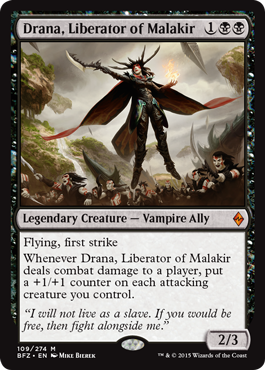 Shall we make some more room on the [mtg_card]Hardened Scales[/mtg_card] bandwagon? Even if you’re not living that dream, Drana’s a great card. She gives you plenty of stats and abilities for your mana investment, and the synergy between her first strike and her triggered ability is particularly elegant—since she deals damage first, your other creatures will get their +1/+1 counters just in time to deal (more) damage. She adds counters to herself, too, which means that she’s a quicker clock on an empty board than you’d think at first glance. Throw in two potentially relevant creature types and you have a winner.
Shall we make some more room on the [mtg_card]Hardened Scales[/mtg_card] bandwagon? Even if you’re not living that dream, Drana’s a great card. She gives you plenty of stats and abilities for your mana investment, and the synergy between her first strike and her triggered ability is particularly elegant—since she deals damage first, your other creatures will get their +1/+1 counters just in time to deal (more) damage. She adds counters to herself, too, which means that she’s a quicker clock on an empty board than you’d think at first glance. Throw in two potentially relevant creature types and you have a winner.
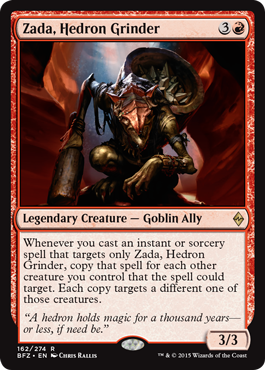 As for other legendaries, Zada makes for a particularly interesting Commander. (Drana’s an interesting one too, pushing you toward a very atypical aggressive black deck.) Zada combines the power of free spell copying with the restriction that you can only [mtg_card]Radiate[/mtg_card] the spell to your own creatures, which means that you have to choose red spells that are generally beneficial. That still leaves plenty of space for shenanigans—the list starts at [mtg_card]Brute Force[/mtg_card] and gets better from there: [mtg_card]Balduvian Rage[/mtg_card] or any other cantrip or combat trick will be good, but you also can get some great effects from [mtg_card]Arcbond[/mtg_card], [mtg_card]Deadshot[/mtg_card], [mtg_card]Twinflame[/mtg_card], [mtg_card]Forge Armor[/mtg_card], [mtg_card]Seize the Day[/mtg_card], and more. For ultimate hilarity, go nuts with [mtg_card]Fiery Gambit[/mtg_card] or [mtg_card]Undying Flames[/mtg_card].
As for other legendaries, Zada makes for a particularly interesting Commander. (Drana’s an interesting one too, pushing you toward a very atypical aggressive black deck.) Zada combines the power of free spell copying with the restriction that you can only [mtg_card]Radiate[/mtg_card] the spell to your own creatures, which means that you have to choose red spells that are generally beneficial. That still leaves plenty of space for shenanigans—the list starts at [mtg_card]Brute Force[/mtg_card] and gets better from there: [mtg_card]Balduvian Rage[/mtg_card] or any other cantrip or combat trick will be good, but you also can get some great effects from [mtg_card]Arcbond[/mtg_card], [mtg_card]Deadshot[/mtg_card], [mtg_card]Twinflame[/mtg_card], [mtg_card]Forge Armor[/mtg_card], [mtg_card]Seize the Day[/mtg_card], and more. For ultimate hilarity, go nuts with [mtg_card]Fiery Gambit[/mtg_card] or [mtg_card]Undying Flames[/mtg_card].
I’m less bullish on Zada in Standard, but if you want a fun idea for an FNM, I recommend pairing Zada with [mtg_card]Dragon Fodder[/mtg_card], [mtg_card]Hordeling Outburst[/mtg_card], and [mtg_card]Might of the Masses[/mtg_card]. That should get out of hand quickly.
 As long as we’re in Commanderland, this card is just fantastic, reminiscent of [mtg_card]Deadwood Treefolk[/mtg_card] with more flexibility. I’ve seen some pros opine that it might have a place in Standard, as well.
As long as we’re in Commanderland, this card is just fantastic, reminiscent of [mtg_card]Deadwood Treefolk[/mtg_card] with more flexibility. I’ve seen some pros opine that it might have a place in Standard, as well.
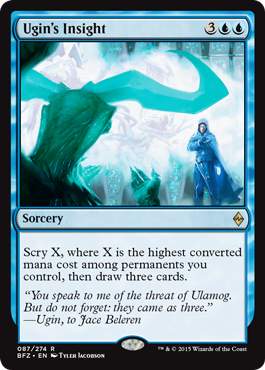 Now here’s a Commander card. Ugin’s Insight is a very unusual card draw spell. Typically, when decks are interested in this sort of thing, they want them cheap and consistent (think [mtg_card]Divination[/mtg_card]) to smooth out the early game, or they want them expensive and instant speed, so that they can hold up removal or counterspells until their opponent’s end step (whereupon they cash in for cards if the opponent didn’t do anything). Ugin’s Insight requires you to play honest in two ways—you have to act at sorcery speed, and you have to be committing things to the board. If you’re willing to play by those rules (and in Commander, they’re not onerous), you get a lot of looks at what you need. I like this much better than hard tutoring: Ugin’s Insight will probably find what you need, but it’s not guaranteed. That makes the game more fun all around.
Now here’s a Commander card. Ugin’s Insight is a very unusual card draw spell. Typically, when decks are interested in this sort of thing, they want them cheap and consistent (think [mtg_card]Divination[/mtg_card]) to smooth out the early game, or they want them expensive and instant speed, so that they can hold up removal or counterspells until their opponent’s end step (whereupon they cash in for cards if the opponent didn’t do anything). Ugin’s Insight requires you to play honest in two ways—you have to act at sorcery speed, and you have to be committing things to the board. If you’re willing to play by those rules (and in Commander, they’re not onerous), you get a lot of looks at what you need. I like this much better than hard tutoring: Ugin’s Insight will probably find what you need, but it’s not guaranteed. That makes the game more fun all around.
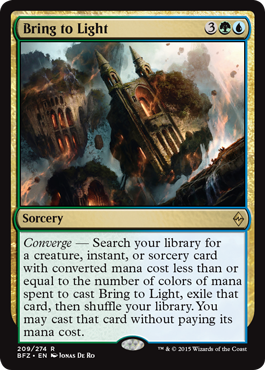 If you’re in the market for a hard tutor, though, Bring to Light is pretty saucy. I’m no Johnny/Jenny, but my sense is that this has the potential to be broken. Tutoring is very good, as has casting things for free, and Bring to Light gives you both; the caveat is that it will never cheat mana and it will never cost less than five mana. Still, if you cast this for at least three colors, you get your tutor at a good rate (two mana, same as [mtg_card]Demonic Tutor[/mtg_card]), or less. That’s pretty exciting.
If you’re in the market for a hard tutor, though, Bring to Light is pretty saucy. I’m no Johnny/Jenny, but my sense is that this has the potential to be broken. Tutoring is very good, as has casting things for free, and Bring to Light gives you both; the caveat is that it will never cheat mana and it will never cost less than five mana. Still, if you cast this for at least three colors, you get your tutor at a good rate (two mana, same as [mtg_card]Demonic Tutor[/mtg_card]), or less. That’s pretty exciting.
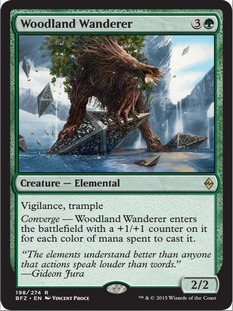 Sadly, Bring to Light doesn’t work so well with some of the other converge cards in the set—if you search up Woodland Wanderer, you won’t actually pay any mana for it, so you won’t get any extra +1/+1 counters. On the other hand, Woodland Wanderer is pretty exciting cast for retail. Even if you only get to three colors (easy, off a flipped [mtg_card]Rattleclaw Mystic[/mtg_card]), Wanderer is a 5/5 that’s tough to block and plays defense to boot. In a [mtg_card]Siege Rhino[/mtg_card] standard, that just might be enough. And if you can get it all the way to 6/6? Well, back in the day we had to play [mtg_card]Hunted Wumpus[/mtg_card] in standard. The times have changed! Though “Woodland Wanderer” does stack up against “Hunted Wumpus” in the “Terrible Names” category.
Sadly, Bring to Light doesn’t work so well with some of the other converge cards in the set—if you search up Woodland Wanderer, you won’t actually pay any mana for it, so you won’t get any extra +1/+1 counters. On the other hand, Woodland Wanderer is pretty exciting cast for retail. Even if you only get to three colors (easy, off a flipped [mtg_card]Rattleclaw Mystic[/mtg_card]), Wanderer is a 5/5 that’s tough to block and plays defense to boot. In a [mtg_card]Siege Rhino[/mtg_card] standard, that just might be enough. And if you can get it all the way to 6/6? Well, back in the day we had to play [mtg_card]Hunted Wumpus[/mtg_card] in standard. The times have changed! Though “Woodland Wanderer” does stack up against “Hunted Wumpus” in the “Terrible Names” category.
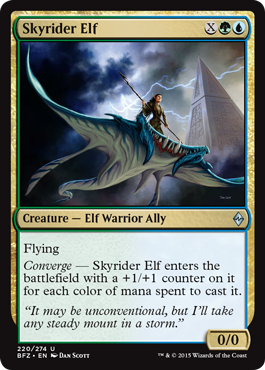 Speaking of converge cards, I suspect Skyrider Elf is much better than it looks at first. Like Endless One, the creature you get is never stunning, but it’s always at least a fair deal, and the flexibility is worth a lot.
Speaking of converge cards, I suspect Skyrider Elf is much better than it looks at first. Like Endless One, the creature you get is never stunning, but it’s always at least a fair deal, and the flexibility is worth a lot.
Almost out of time, and there’s still so much to cover! Let’s try blocking some of these cards together.
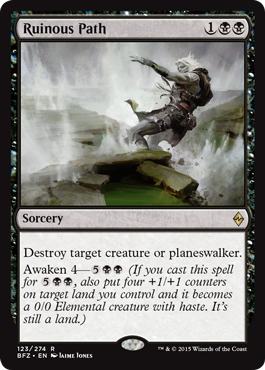
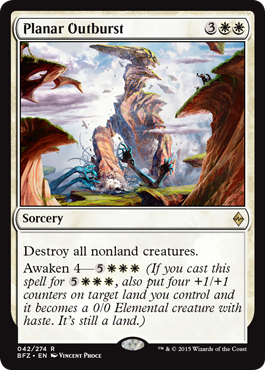 So far, the cards with awaken have seemed like essentially efficient versions of cards that already exist (in this case, [mtg_card]Hero’s Downfall[/mtg_card] and [mtg_card]End Hostilities[/mtg_card]), which sacrifice a small amount of power or flexibility up front for a huge payoff in the lategame. These cards all seem very, very good to me; they’re not much worse than their counterparts, but their awaken abilities are game-altering, even if they do only come up in one game out of five or ten. These cards let midrange or control decks that play with the late game in mind to turn the corner and start attacking with a substantial creature very quickly—immediately, in fact, if they ever get cast with an extra land untapped. In Commander, these are all great: they’re reasonably priced versions of spells you probably want anyway, with huge upside if you happen to draw them late.
So far, the cards with awaken have seemed like essentially efficient versions of cards that already exist (in this case, [mtg_card]Hero’s Downfall[/mtg_card] and [mtg_card]End Hostilities[/mtg_card]), which sacrifice a small amount of power or flexibility up front for a huge payoff in the lategame. These cards all seem very, very good to me; they’re not much worse than their counterparts, but their awaken abilities are game-altering, even if they do only come up in one game out of five or ten. These cards let midrange or control decks that play with the late game in mind to turn the corner and start attacking with a substantial creature very quickly—immediately, in fact, if they ever get cast with an extra land untapped. In Commander, these are all great: they’re reasonably priced versions of spells you probably want anyway, with huge upside if you happen to draw them late.


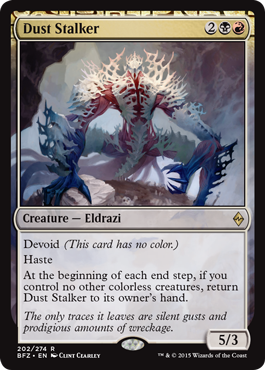 Meanwhile, the devoid cards have me puzzled. It seems like we’re very close to a Grixis (blue-black-red) or Jund (black-red-green) devoid aggro deck; it still isn’t clear, as with so many things from this set, whether that will be strong enough to support a deck in Standard.
Meanwhile, the devoid cards have me puzzled. It seems like we’re very close to a Grixis (blue-black-red) or Jund (black-red-green) devoid aggro deck; it still isn’t clear, as with so many things from this set, whether that will be strong enough to support a deck in Standard.
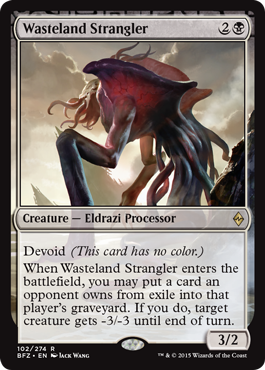
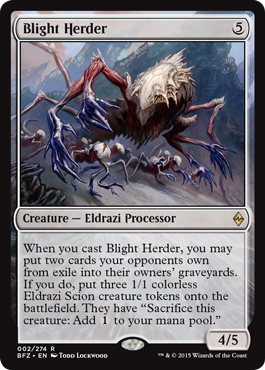
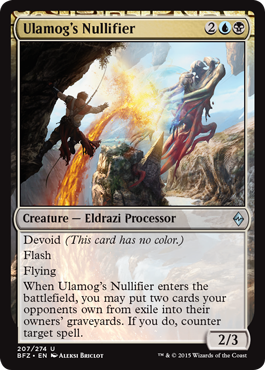 Ditto for the Eldrazi Processor cards. All three of these cards offer very strong effects for their mana cost, so long as you can pay the additional cost of exiling a few cards from your opponent’s deck or battlefield. These are very hard to evaluate, as we haven’t seen the full set of enablers; cards with ingest help to set these up, of course, but we haven’t yet seen an ingest-er that’s compelling on its own. It may fall to setup cards like Transgress the Mind or Horribly Awry to make other cards like Wasteland Strangler playable on curve.
Ditto for the Eldrazi Processor cards. All three of these cards offer very strong effects for their mana cost, so long as you can pay the additional cost of exiling a few cards from your opponent’s deck or battlefield. These are very hard to evaluate, as we haven’t seen the full set of enablers; cards with ingest help to set these up, of course, but we haven’t yet seen an ingest-er that’s compelling on its own. It may fall to setup cards like Transgress the Mind or Horribly Awry to make other cards like Wasteland Strangler playable on curve.
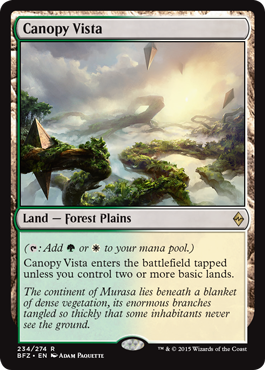
 Lastly—but perhaps most importantly—we have the lands. Many players have commented, following a koan established by Hall of Famer Zvi Moshowitz, that this upcoming Standard format will depend a lot on what the lands make possible.
Lastly—but perhaps most importantly—we have the lands. Many players have commented, following a koan established by Hall of Famer Zvi Moshowitz, that this upcoming Standard format will depend a lot on what the lands make possible.
To that end, the conventional wisdom seems to be that Canopy Vista and its friends will strongly support two and three color decks, the latter strongly centered around “shards”—that is, one color and its two allies. A Bant deck (green-white-blue), for example, could play both [mtg_card]Flooded Strand[/mtg_card] and [mtg_card]Windswept Heath[/mtg_card], either of which could find Canopy Vista or Prairie Stream. With a healthy dose of basics, it’s trivially easy to get white, blue, and green mana online, and most of your lands won’t even come into play tapped.
It’s even better if you’re playing a two-color deck, particularly if that deck focuses on one color with a small splash of another. Let’s say you play a manabase of eight Forests, two Plains, four Windswept Heath, four Wooded Foothills, and four Canopy Vista. It’s trivially easy for you to open up with two basic lands, at which point any of your fetchlands can find an untapped Canopy Vista to enable your white mana.
Pushing against that trend toward two-color and three-color shard manabases are the tri-lands from Khans of Tarkir, [mtg_card]Sandsteppe Citadel[/mtg_card] et al. Those decks can also take advantage of the enemy manlands, Shambling Vent and Lumbering Falls, both of which are very good. In the bargain, they also get the most powerful cards from Khans block, hits like [mtg_card]Siege Rhino[/mtg_card], [mtg_card]Mantis Rider[/mtg_card], and [mtg_card]Savage Knuckleblade[/mtg_card]. And all this is to say nothing of more ambitious manabases that push for a fourth or fifth color!
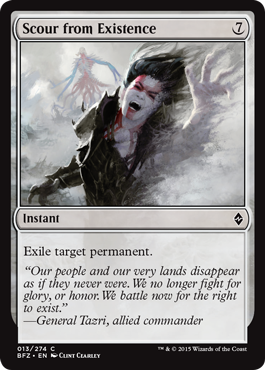 One last card before I wrap up. Scour from Existence isn’t going to set any efficiency records, and I’d be mildly surprised if it ever showed up in Standard. That said, I’m thrilled it exists. In designing decks to introduce new players to Magic, I’ve been thinking a lot about simple, staple effects—like unconditional removal—especially ones that can go into any (or almost any) deck. In fact, I was on the cusp of designing my own card (six or seven mana, sorcery, exile target permanent), just to make sure that every deck could have access to a guaranteed answer, if it needed it. It’s not that Scour from Existence is a good card, per se. It’s that it can go in every deck, so every beginner can know that there is at least one card, somewhere in their deck, that can bail them out of a difficult situation. That guarantee is a big deal to new players. Psychologically, Scour from Existence represents the difference between helplessness and hope. That’s a tremendous load for a humble common to take up, but Scour does the job admirably.
One last card before I wrap up. Scour from Existence isn’t going to set any efficiency records, and I’d be mildly surprised if it ever showed up in Standard. That said, I’m thrilled it exists. In designing decks to introduce new players to Magic, I’ve been thinking a lot about simple, staple effects—like unconditional removal—especially ones that can go into any (or almost any) deck. In fact, I was on the cusp of designing my own card (six or seven mana, sorcery, exile target permanent), just to make sure that every deck could have access to a guaranteed answer, if it needed it. It’s not that Scour from Existence is a good card, per se. It’s that it can go in every deck, so every beginner can know that there is at least one card, somewhere in their deck, that can bail them out of a difficult situation. That guarantee is a big deal to new players. Psychologically, Scour from Existence represents the difference between helplessness and hope. That’s a tremendous load for a humble common to take up, but Scour does the job admirably.
Almost 3500 words in, and it feels like we’ve barely scratched the surface of Battle for Zendikar! There are certainly some powerful cards in this set, and even if it’s unclear what strategies will be the best, BFZ seems poised to shake up Standard in a big way.
Meanwhile, we have a brand new limited environment on the way, too! I’ll be back next week with another limited set review, just in time for the prerelease. In the meantime, enjoy the last few spoilers, as well as the full set list, as soon as it goes up!
As always, hit me up here in the comments or on Twitter (@cutefuzzy_) if there’s anything you’d like to discuss further.

2 comments